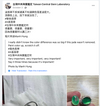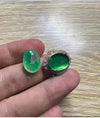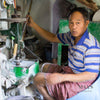Fake Jade with Fake Certificate from China
A Gemologist Review
A couple of months ago while I was browsing through my social media feeds, a post from the Taiwan Central Gem Laboratory caught my attention with pictures of what appears to be two jade cabochon rings with certificates. But the stones were dismounted from the setting and the background of the picture was littered with green coloured scrapings. The immediate thought that came to mind was someone has been scammed, again. And probably lost a whole lot of money. To protect the jade industry and our consumers from these cunning tricks, I will attempt to debunk the practices of these deceitful jade sellers in this article; explaining how even a trained gemologist can be deceived.

The “Very Important…Very important!” Post
The author of the post wrote in Chinese: “This jade, if not removed, you really wouldn’t know the colour difference is so significant. The lacquer colour applied, when scraped off, loses its colour. Very important, very important, very important! Because it’s crucial, I’m saying it three times!”
Upon interviewing the original author, a representative of the Taiwanese gemological lab, he revealed that his Vietnamese client had bought the jade rings from a prominent jade region in China with certification showing that they are Grade A natural jadeite jade. The photos within the certificates showed vibrant green jade cabochons mounted on white metal rings. Where in fact when the stones were dismounted, the vivid green colour of the stones had turned colourless. The green colour came from the painted green pigmented resin-like material at the base of the ring mounts. This is very important because one of the main quality factors of jadeite is its colour and imperial green colour like that will fetch the biggest dollars. With the colour gone, so is the value of the stones.

Figure 1.1: Shows two ring settings with a green colour base and the certificates with photos of what they looked like when the stones were mounted.
How this Jade Treatment Works
The treatment works by enhancing the colour of the jade using green pigmented glue-like material painted on the base of the ring mounts but the stones themselves are not treated. The colourless stones in the photos were tested to be natural jadeite jade. When a highly translucent colourless jade cabochon is placed on top, the painted-on green colour at the base is transmitted and dispersed throughout the stone making it green. The method isn't groundbreaking; I've witnessed skilled cutters transform near-colourless Ceylon sapphires into vibrant blues. They achieve this by strategic placement of colour centres within the stones.

Figure 1.2: Shows the difference in colour between the mounted and unmounted stones.
Why is it “Very Important”?
One of the questions that I asked the author of the post was what prompted him to dismount the stones in the first place. To which he replied “Client did it by herself". This is crucial because most laboratories or jewellery valuers would not dismount an already set stone for testing.
Here’s why this relatively simple trick is so important to consumers and gemologists alike; it’s hard to detect (when the stone is mounted) using traditional gemological testing techniques or even with advanced spectrometers. That’s because the stones themselves are real, untreated jadeite. Typically, when a stone is mounted, gemologists face limitations in conducting comprehensive tests. As an example, a traditional refractometer would still read the R.I. of jadeite because the mounted stones are genuine. Similarly, when placed in an infrared spectrometer (FTIR), only a reflectance measurement can be made near the surface of the stone which will likely result in a natural jadeite spectrum.
Because of the limitations with testing a mounted stone, there’s a possibility that the Chinese laboratory that issued the certificates could have missed the treatment and had deemed them ‘A Jade’. Hence, I asked the author of the post: “Would it be safe to presume the lab that issued the certificates missed this treatment or is it a fake certification? The author replied: “This is fake certification.”.
The Value of Green vs White Jade
The value of a jadeite cabochon is governed by five quality factors: colour, translucency, texture, cut, and weight. For most, colour is the most important factor and typically has the highest consideration when it comes to valuing Burmese jade. Leaving all other quality factors constant, a vivid green jade is significantly rarer and more expensive than colourless jade. For instance, a 3 carat highly translucent green natural jadeite cabochon has a value of $6000 whereas a 3 carat highly translucent colourless natural jadeite cabochon has a value of $600. The difference is ten folds.

Figure 1.3: Some of the resin-like glue appears to be on the base of the jade aswell.
How to avoid Jade Scams
Scams especially involving jade stones are not uncommon. In fact, the internet is filled with treated jade stones or jade bangles being sold as genuine. Some even include fake certificates like in this article. In the first three months of 2023 alone, there have been 10 victims from Singapore that lost at least $95,000 to scammers on social media platforms like Tiktok. To avoid falling victim to these scams follow the these tips:
1. Buy from a Reputable Business
Without a doubt buying from a reputable jade shop is the safest option. But what defines a reputable business? There are popular jewellery franchises that sell “jade” products without disclosing the stones’ identity or treatments. Or online sellers on social media platforms flaunting their ‘jade education’ by clanking two jade bangles together as a definitive test of authenticity. Please choose wisely.
2. Accept Certificates from a Reputable Lab
If the product is accompanied by a certificate, ensure the issuer is genuine and reputable. Internationally renowned gem labs like the GIA have features to authenticate their certificates online.
All images used with permission from the original author of the social media post. They belong to their respective copyright holders.

WAI YAN










I am curious to find out whether conducting a burn/ heat test from a lighter is reliable to determine a Jade is natural or treated. I have bought a few pieces of semi-finished and finished Jade and performed a burn test and observed that it had released some kind of chemical or plastic odour and the colour turned brown and black. Can I concluded that the jade is treated and it is man made Jade?
Learned another way of faking jade from this article. Colored glass, jade stone powder mixed with epoxy, and chemical treatment of stones are other ways. Few people actually know what real jade looks like. The “jade” most people, including sellers, have seen is fake. The fact that something is expensive doesn’t assure its authenticity. Truly, “Let the buyer beware.”
Thank you so much for knowing about Jade
Dear Ernesto .E,
Please feel free to send us a photo and we can provide you with a preliminary valuation if possible. Although, I would recommend that you bring these dragon statues to a local jewelry valuer for proper assessment.
I have 2white jade statues with dragons on bottom and one on top. How can get a value,, location of origin and any thing else I need to no bout them.. they are white ,,2.6 pounds each.. I think male and female . Let me no please adap